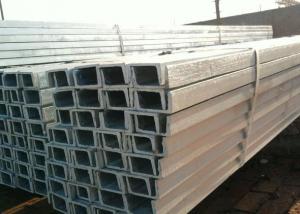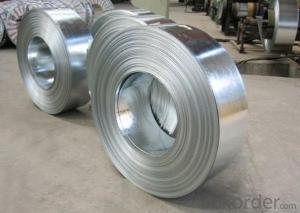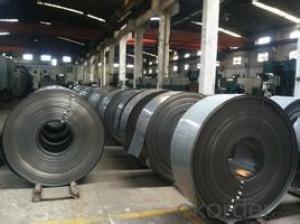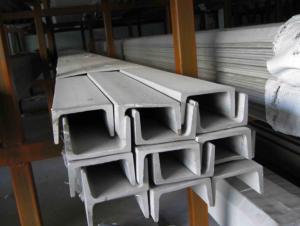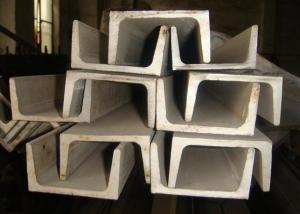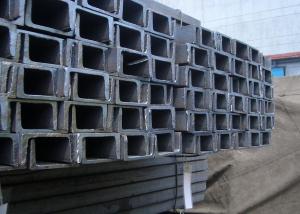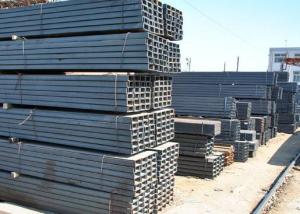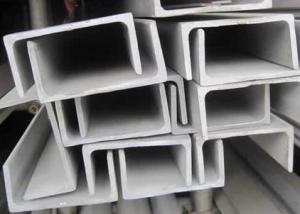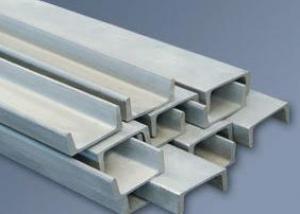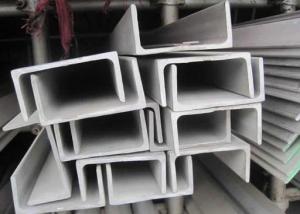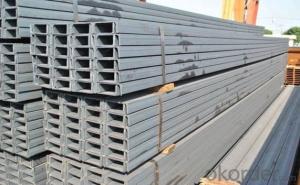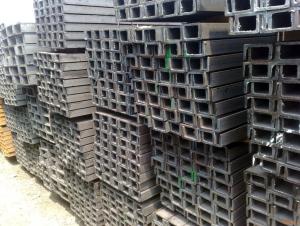316L Stainless Steel Channels-SUM,316L
- Loading Port:
- China Main Port
- Payment Terms:
- TT or LC
- Min Order Qty:
- 5 Tons m.t.
- Supply Capability:
- 1000 Tons Per Month m.t./month
OKorder Service Pledge
OKorder Financial Service
You Might Also Like
Stainless Steel Channel
1.Size: 3mm to 24mm Thickness
2.Material:SUS201,202,301,304,304L,316,316L ,321 etc.
3.Length: 4m to 6m,or according to the customer's requirement
4.Standard: AISI,JIS,GB,DIN
5.Finish: Cold Drawn ,hot rolled & Polishing
6.Testing: Each heat number and batch must be tested for both chemical and mechanical properties
7.Application: Produce screw and nut, engine parts, indoor and outdoor decorating,etc.
|
Size (mm) |
Thickness (mm) | ||||||||
|
H×B |
3 |
4 |
5 |
6 |
7 |
8 |
9 |
10 |
12 |
|
Mass (Kg/m) | |||||||||
|
40×20 |
1.79 |
|
|
|
|
|
|
|
|
|
50×25 |
2.27 |
|
|
|
|
|
|
|
|
|
60×30 |
2.74 |
3.56 |
4.37 |
5.12 |
|
|
|
|
|
|
70×35 |
3.23 |
4.21 |
5.17 |
6.08 |
|
|
|
|
|
|
80×40 |
3.71 |
4.84 |
5.96 |
7.03 |
|
|
|
|
|
|
90×45 |
4.25 |
5.55 |
6.83 |
8.05 |
|
|
|
|
|
|
100×50 |
4.73 |
6.18 |
7.62 |
8.98 |
10.3 |
11.7 |
13 |
41.2 |
|
|
120×60 |
|
|
9.2 |
10.9 |
12.6 |
14.2 |
|
|
|
|
130×65 |
|
|
10.1 |
11.9 |
13.8 |
15.5 |
17.3 |
19.1 |
|
|
140×70 |
|
|
|
12.9 |
14.9 |
16.8 |
18.8 |
20.7 |
|
|
150×75 |
|
|
|
13.9 |
16 |
18.1 |
20.2 |
22.2 |
26.3 |
|
160×80 |
|
|
|
14.8 |
17.1 |
19.3 |
21.6 |
23.8 |
28.1 |
|
180×90 |
|
|
|
16.7 |
19.4 |
22 |
24.5 |
27 |
32 |
|
200×100 |
|
|
|
18.6 |
21.6 |
24.5 |
27.4 |
30.2 |
35.8 |
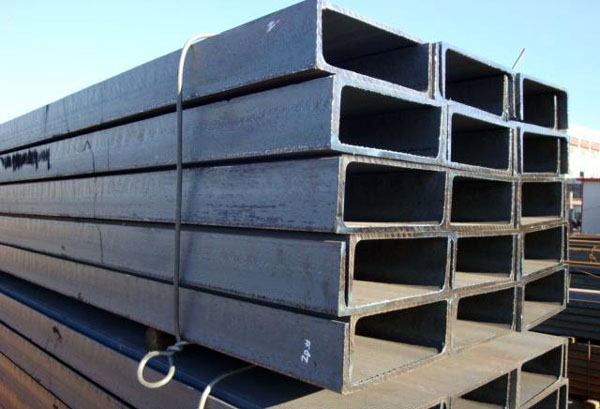
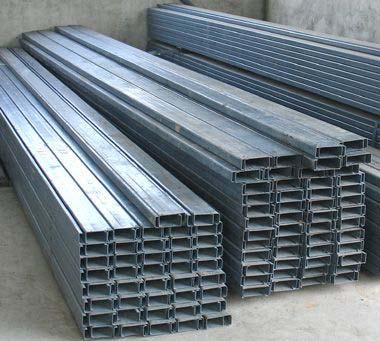
- Q:Are stainless steel channels suitable for electrical applications?
- Yes, stainless steel channels are suitable for electrical applications. Stainless steel is known for its excellent corrosion resistance, durability, and high strength-to-weight ratio, making it a reliable choice for electrical installations. Additionally, stainless steel channels provide protection and support for electrical wiring and cables, ensuring their safety and longevity.
- Q:Can stainless steel channels be used for solar panel mounting systems?
- Absolutely, solar panel mounting systems can definitely utilize stainless steel channels. Stainless steel is highly favored in the selection of materials for solar panel mounting systems because of its exceptional endurance, resistance to corrosion, and robustness. It can endure diverse weather conditions without succumbing to rust or deterioration, thereby establishing a dependable choice for extended periods of use. Furthermore, stainless steel channels furnish a steadfast and secure foundation for the installation of solar panels, guaranteeing their appropriate support and safeguarding.
- Q:What are the different edge profiles available for stainless steel channels?
- There are several different edge profiles available for stainless steel channels that can enhance their functionality and aesthetic appeal. Some of the most common edge profiles include: 1. Square Edge: This is the most basic and straightforward edge profile, where the edges of the stainless steel channel are left square and sharp. It provides a clean and modern look. 2. Rounded Edge: This profile features rounded edges that are slightly curved. It not only adds a softer and more elegant touch to the channel but also helps prevent injury from sharp edges. 3. Beveled Edge: A beveled edge is created by cutting and shaping the edges of the channel at an angle. This profile is often used for decorative purposes and can create a visually interesting and distinctive look. 4. Bullnose Edge: A bullnose edge is similar to a rounded edge but has a more pronounced curve. This profile is commonly used in architectural applications where a smooth and rounded finish is desired. 5. Chamfered Edge: This profile involves cutting and shaping the edges of the channel at a 45-degree angle, creating a beveled edge. It is often used to reduce sharpness and improve safety while maintaining a sleek and modern appearance. These are just a few examples of the edge profiles available for stainless steel channels. The choice of profile depends on the specific application, desired aesthetics, and functional requirements of the channel. It is important to consult with a professional or supplier to determine the most suitable edge profile for your specific needs.
- Q:Are stainless steel channels suitable for HVAC systems?
- Yes, stainless steel channels are suitable for HVAC systems. Stainless steel is highly resistant to corrosion, which is crucial for HVAC systems that are exposed to moisture and varying temperatures. It also offers durability and strength, making it an ideal choice for supporting and distributing air in HVAC applications. Additionally, stainless steel channels have excellent aesthetic appeal and can be easily cleaned, making them a reliable and hygienic option for HVAC systems.
- Q:What is the cost of stainless steel channels?
- The price of stainless steel channels may differ due to several factors, including the stainless steel grade, channel size and dimensions, and the supplier or manufacturer. Typically, stainless steel channels are priced per linear foot or length, with prices ranging from a few dollars to several hundred dollars per foot. To obtain precise and current pricing information tailored to your specific needs, it is recommended to reach out to multiple suppliers or manufacturers.
- Q:Can stainless steel channels be used for recreational or sports facilities?
- Yes, stainless steel channels can be used for recreational or sports facilities. Stainless steel is a durable and corrosion-resistant material, making it suitable for environments that are subject to moisture, chemicals, and high impact. Stainless steel channels can be used in various applications such as handrails, guardrails, bleachers, and equipment supports in recreational or sports facilities. Additionally, stainless steel channels are easy to clean and maintain, ensuring a hygienic and safe environment for users. Their sleek and modern appearance also adds aesthetic value to the facilities. Overall, stainless steel channels provide a reliable and long-lasting solution for recreational or sports facilities.
- Q:What are the different load distribution methods for stainless steel channels?
- Different load distribution methods are available for stainless steel channels based on specific requirements and structural considerations. Some commonly used methods include: 1. Uniform load distribution: This method evenly distributes the load along the entire length of the stainless steel channel. It is suitable for lighter loads or situations where the load is evenly spread out. 2. Concentrated load distribution: With this method, the load is concentrated at specific points on the stainless steel channel. It is often used for heavier loads or situations where the load is not evenly distributed. 3. Cantilever load distribution: This method involves supporting the load at one end of the stainless steel channel while allowing it to freely extend at the other end. It is typically used when there is an overhanging or unsupported section of the channel. 4. Combined load distribution: In complex load patterns, a combination of different load distribution methods may be necessary. For example, a stainless steel channel may need to support both uniform and concentrated loads simultaneously. In such cases, a combination of load distribution methods can be employed. When determining the appropriate load distribution method, it is crucial to consider factors like the weight and distribution of the load, the strength and structural integrity of the stainless steel channel, and any specific requirements or regulations. Seeking guidance from a structural engineer or a professional experienced in stainless steel channel design can ensure the selection of the most suitable load distribution method for a particular application.
- Q:What are the different jointing methods for stainless steel channels?
- Some common jointing methods for stainless steel channels include welding, bolting, and adhesive bonding. Welding involves melting the edges of the channels and fusing them together, creating a strong and seamless joint. Bolting involves using bolts, nuts, and washers to secure the channels together, allowing for easy disassembly if needed. Adhesive bonding involves using a high-strength adhesive to bond the channels together, providing a strong and durable joint. Each method has its own advantages and considerations, depending on factors such as the application, load requirements, and aesthetic preferences.
- Q:Are stainless steel channels suitable for framing glass panels?
- Yes, stainless steel channels are suitable for framing glass panels. Stainless steel channels provide a strong and durable framework for supporting and securing glass panels in place. They offer excellent resistance to corrosion and are often used in architectural applications where aesthetics and strength are important.
- Q:What are the different types of accessories or fittings available for stainless steel channels?
- Depending on the specific application and requirements, there exists a variety of accessories and fittings for stainless steel channels. Some commonly used types are as follows: 1. To ensure a polished appearance and eliminate sharp edges on the ends of stainless steel channels, end caps can be easily affixed to provide both safety and aesthetics. 2. Brackets, available in different shapes and sizes such as L-shaped or U-shaped, are employed to support and secure the stainless steel channel in various installations, offering stability and strength to the overall structure. 3. Joining plates, typically crafted from stainless steel, are utilized to connect two or more stainless steel channels together. These plates establish a robust connection, ensuring alignment and security. 4. Mounting hardware, including screws, bolts, and nuts, are essential in firmly attaching the stainless steel channel to a surface or structure, guaranteeing proper installation and stability. 5. Hangers and supports are employed to suspend or elevate stainless steel channels in applications like cable management or piping systems. These additions provide stability and prevent sagging or bending, allowing for efficient operation and longevity. 6. Clamps and clips are utilized to secure cables, pipes, or other components to the stainless steel channels, offering a secure and organized arrangement within the channel structure. 7. Covers and shields are used to safeguard the contents within the stainless steel channel from dust, dirt, moisture, and external factors. These protective coverings can be easily attached or removed as needed, adding extra security and shielding. In conclusion, these accessories and fittings not only enhance the functionality, durability, and aesthetics of stainless steel channels but also make them versatile for a wide range of applications in various industries such as construction, manufacturing, and infrastructure development.
1. Manufacturer Overview |
|
|---|---|
| Location | Jiangsu, China |
| Year Established | 2010 |
| Annual Output Value | above US$8 million |
| Main Markets | East Asia, Middle East, West Europe |
| Company Certifications | |
2. Manufacturer Certificates |
|
|---|---|
| a) Certification Name | |
| Range | |
| Reference | |
| Validity Period | |
3. Manufacturer Capability |
|
|---|---|
| a)Trade Capacity | |
| Nearest Port | Shanghai |
| Export Percentage | |
| No.of Employees in Trade Department | above 50 people |
| Language Spoken: | English, Chinese, Arabic |
| b)Factory Information | |
| Factory Size: | about 15000 square meter |
| No. of Production Lines | above 4 |
| Contract Manufacturing | OEM Service Offered,Design Service Offered |
| Product Price Range | Average |
Send your message to us
316L Stainless Steel Channels-SUM,316L
- Loading Port:
- China Main Port
- Payment Terms:
- TT or LC
- Min Order Qty:
- 5 Tons m.t.
- Supply Capability:
- 1000 Tons Per Month m.t./month
OKorder Service Pledge
OKorder Financial Service
Similar products
New products
Hot products
Related keywords
